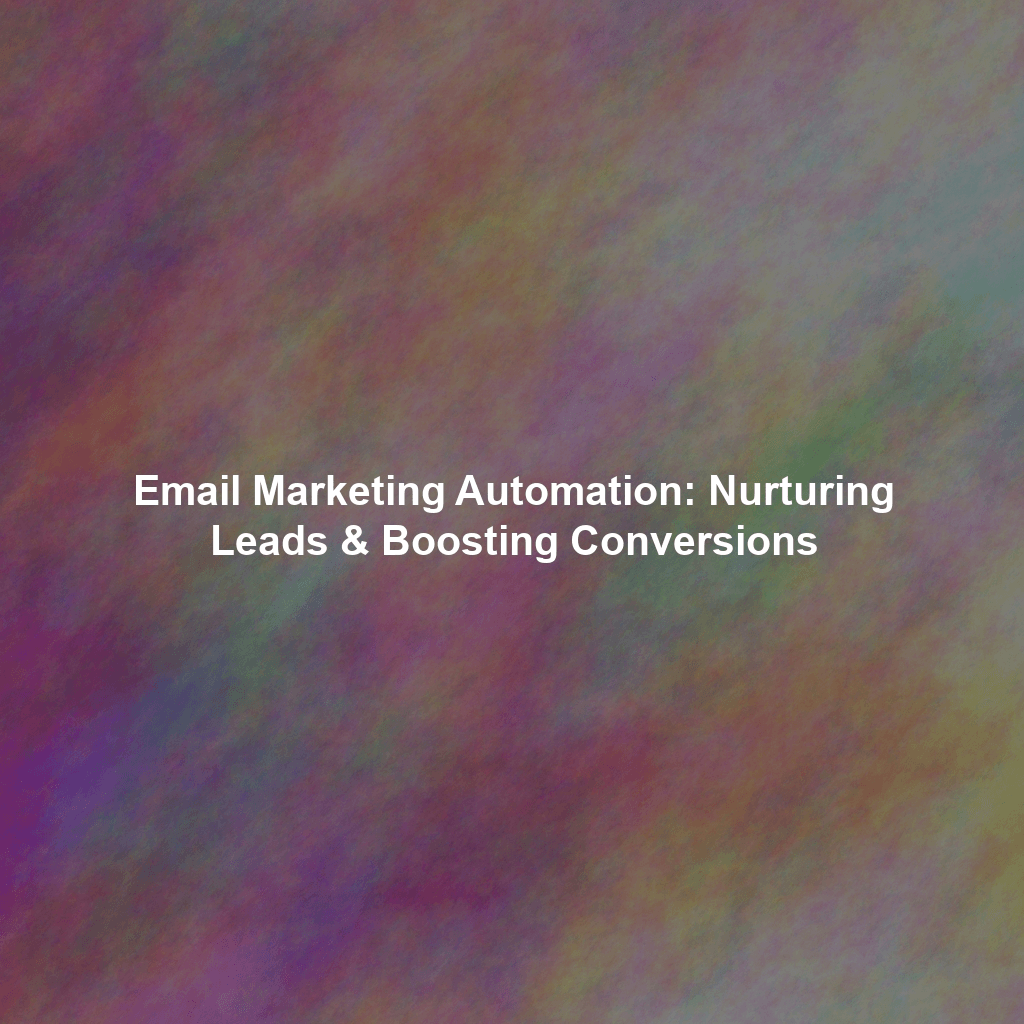In today’s digital landscape, effective marketing communication is paramount. While countless strategies vie for attention, email marketing remains a powerhouse – especially when amplified by automation. Email marketing automation isn’t just about sending emails; it’s about crafting personalized experiences that nurture leads, build relationships, and ultimately, drive conversions. It’s the intelligent application of technology to streamline and optimize your email campaigns, ensuring the right message reaches the right person at the right time.
What is Email Marketing Automation?
At its core, email marketing automation involves using software and pre-defined rules to automatically send emails to subscribers based on specific triggers and actions. These triggers can range from a user subscribing to your newsletter, downloading a resource, making a purchase, or even abandoning their shopping cart. Instead of manually composing and sending each email, you create automated workflows that handle the process, freeing up your time and resources.
Key Components of Email Marketing Automation:
- Triggers: Events or actions that initiate an automated email sequence (e.g., subscribing, clicking a link, visiting a webpage).
- Segments: Grouping subscribers based on shared characteristics or behaviors (e.g., demographics, interests, purchase history).
- Workflows: Pre-defined sequences of emails and actions that are triggered by specific events.
- Personalization: Tailoring email content to individual subscribers based on their data and preferences.
- Analytics: Tracking key metrics like open rates, click-through rates, and conversion rates to measure the effectiveness of your campaigns.
The Benefits of Email Marketing Automation: Why Should You Care?
Implementing email marketing automation offers a wealth of benefits, far exceeding simple time savings. It’s a strategic investment that can significantly impact your bottom line.
Improved Lead Nurturing:
Lead nurturing is the process of building relationships with potential customers throughout the sales funnel. Automated email sequences can deliver targeted content that addresses their specific needs and concerns at each stage, guiding them towards a purchase decision. By providing valuable information and building trust, you increase the likelihood of converting leads into paying customers.
Increased Conversion Rates:
Targeted and personalized emails are far more effective than generic broadcasts. Email marketing automation allows you to segment your audience and deliver relevant offers and content that resonate with their interests. This leads to higher engagement, click-through rates, and ultimately, increased conversion rates.
Enhanced Customer Engagement:
Automated emails can be used to welcome new subscribers, provide ongoing support, celebrate milestones, and gather feedback. This proactive engagement fosters a sense of connection and loyalty, turning customers into brand advocates.
Time Savings and Efficiency:
By automating repetitive tasks, such as sending welcome emails or follow-up messages, you free up your time to focus on more strategic initiatives. This increased efficiency allows you to optimize your marketing efforts and achieve better results with fewer resources.
Better Segmentation and Personalization:
Automation allows for sophisticated segmentation based on various data points, leading to highly personalized email experiences. This ensures that each subscriber receives content that is relevant and engaging, increasing the likelihood of conversion.
Data-Driven Optimization:
Email marketing automation platforms provide detailed analytics that track the performance of your campaigns. This data allows you to identify areas for improvement, optimize your messaging, and refine your targeting strategies.
Common Email Marketing Automation Workflows
Understanding common automation workflows is crucial for creating an effective email marketing strategy. Here are some popular examples:
Welcome Series:
A welcome series is a sequence of emails that are automatically sent to new subscribers. It typically includes an introduction to your brand, a thank you for subscribing, and an offer to encourage their first purchase. This is a crucial opportunity to make a positive first impression and establish a connection with new subscribers.
Lead Magnet Delivery:
When someone downloads a lead magnet (e.g., an ebook, checklist, or whitepaper), an automated email can deliver the resource and then follow up with additional relevant content to nurture them further down the sales funnel.
Abandoned Cart Emails:
If a customer adds items to their shopping cart but doesn’t complete the purchase, an automated email can remind them of the items and offer an incentive to complete the transaction (e.g., free shipping or a discount). These emails are highly effective in recovering lost sales.
Post-Purchase Follow-up:
After a customer makes a purchase, an automated email can thank them for their order, provide shipping updates, and ask for feedback. This demonstrates that you value their business and helps build customer loyalty.
Birthday and Anniversary Emails:
Sending automated birthday or anniversary emails with a special offer is a great way to personalize the customer experience and build goodwill. These emails show that you care about your customers and appreciate their loyalty.
Re-engagement Campaigns:
If subscribers haven’t engaged with your emails in a while, a re-engagement campaign can be used to win them back. This might involve sending a special offer, asking them to update their preferences, or simply reminding them of the value you provide.
Best Practices for Effective Email Marketing Automation
While automation tools make the process easier, success hinges on following best practices.
Define Your Goals:
What do you want to achieve with email marketing automation? Increased sales? More leads? Improved customer retention? Clearly defined goals will guide your strategy and help you measure your success.
Know Your Audience:
Understanding your target audience is crucial for creating effective email campaigns. Segment your audience based on demographics, interests, purchase history, and other relevant factors to deliver personalized content that resonates with them.
Craft Compelling Content:
Your emails should be engaging, informative, and relevant to your audience. Use clear and concise language, compelling visuals, and a strong call to action.
Personalize Your Emails:
Personalization goes beyond simply using the subscriber’s name. Use dynamic content to tailor the email based on their interests, purchase history, and other relevant data.
Optimize for Mobile:
A significant portion of emails are opened on mobile devices. Ensure that your emails are responsive and display correctly on all screen sizes.
Test, Test, Test:
A/B testing different subject lines, email content, and calls to action to optimize your campaigns for maximum effectiveness. Continuously analyze your results and make adjustments as needed.
Track Your Results:
Monitor key metrics like open rates, click-through rates, conversion rates, and unsubscribe rates to measure the performance of your campaigns. Use this data to identify areas for improvement and optimize your strategy.
Comply with Regulations:
Ensure that your email marketing practices comply with all relevant regulations, such as GDPR and CAN-SPAM. This includes obtaining consent from subscribers before sending emails and providing a clear and easy way to unsubscribe.
Don’t Over-Automate:
While automation is powerful, it’s important to avoid over-automating your email marketing. Personalize your approach and ensure that your emails feel genuine and human.
Choosing the Right Email Marketing Automation Tool
Numerous email marketing automation platforms are available, each with its own strengths and weaknesses. Consider these factors when making your selection:
Features and Functionality:
Does the platform offer the features you need, such as segmentation, automation workflows, personalization, A/B testing, and analytics?
Integration with Other Tools:
Does the platform integrate with your CRM, e-commerce platform, and other marketing tools?
Ease of Use:
Is the platform user-friendly and easy to learn? A complex and difficult-to-use platform can hinder your progress.
Pricing:
What is the pricing structure, and does it fit your budget? Consider the cost per email, number of subscribers, and other features.
Customer Support:
Does the platform offer reliable customer support? Good support is essential for resolving issues and getting the most out of the platform.
Popular email marketing automation platforms include Mailchimp, ActiveCampaign, HubSpot, Sendinblue, and ConvertKit. Research and compare these options to find the best fit for your specific needs.
Conclusion: Unleash the Power of Automated Email Marketing
Email marketing automation is more than just a trend; it’s a fundamental shift in how businesses communicate with their audience. By embracing automation, you can nurture leads, boost conversions, and build lasting relationships with your customers. Start small, experiment with different workflows, and continuously optimize your strategy based on the data you collect. With the right approach and tools, you can unlock the immense potential of email marketing automation and drive significant growth for your business.
Investing the time and effort to learn and implement email marketing automation will yield significant returns. It empowers you to connect with your audience on a personal level, deliver relevant content at the right time, and ultimately, achieve your marketing goals with greater efficiency and effectiveness. So, take the leap and transform your email marketing from a reactive task to a proactive engine for growth.
 Skip to content
Skip to content

